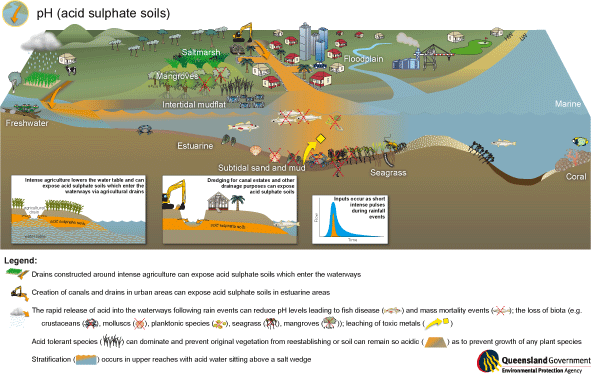Our current best conceptual understanding of the stressor ‘pH’ is shown in Figure 1.
Figure 1. Potential causes of a change to pH and the condition responses observed as a result of this change.
The pH of water relates to how acidic (pH <7) or alkaline (pH >7) the water body is. Although pH can be altered by industrial discharges, fertilisers, detergents and insecticides, the key human activity which results in a change to the stressor ‘pH’ is the disturbance of Acid Sulphate Soils (ASS). Acid run-off is caused by exposure of sulphides to oxygen and their subsequent oxidation and conversion to sulphuric acid in the presence of water. Sulphide-rich rocks or soils occur naturally in subsurface areas where oxygen does not normally penetrate. Exposure of sulphide-rich deposits may occur due to mining activity, agricultural activity or construction (e.g. tidal canals, housing estates). Acid sulphate soils are by far the most common cause of acid run-off entering estuaries because many coastal flood plains contain large deposits of subsurface sulphide-rich soils.
The main effect of acid run-off is to reduce pH levels but it can also mobilise heavy metals which have additional toxic effects. Because of the high buffering capacity of sea water, small amounts of acid run-off may not have noticeable effects. However, large acid run-off events can cause major mortality of both fish and benthic organisms. Changes in pH affect the form and activity of many chemicals, making them more or less harmful to organisms depending on the chemical type and the nature of the pH change. Residence times/flushing rates/dilution efficiency and the natural buffering ability of estuarine/marine waters are natural mediating factors which influence the impact of pH on the ecosystem.



